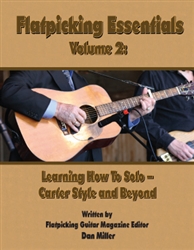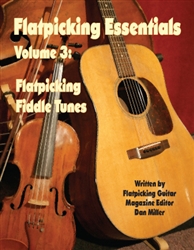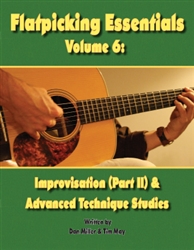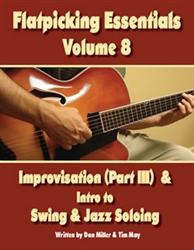Order Flatpicking Essentials
This comprehensive 8 Volume course
contains a complete method of learning how to play pick style acoustic
guitar. Each volume provides step-by-step instruction covering everything from fundamentals to highly complex techniques. Whether you
are a beginner or an advanced flatpicker, "Flatpicking Essentials" will
help you to push your playing to the next level. Each volume comes
with a CD so you can hear how a style or technique is played. We also
offer the course in a digital format.
The foundation of the
course is based on the proven learning method developed by Dan Miller
and Tim May who collectively have over 40 years experience of teaching
and professionally playing acoustic string instruments. "Flatpicking
Essentials" differs from other teaching methods because it teaches you
not only how to play, but also how to learn so that you are able to
fully master new concepts and techniques.
"Flatpicking Essentials" was one of
the few pick style books to be awarded a spot in "The 50 Greatest Guitar
Books" by Shawn Persinger.
To Order any of the Flatpicking Essentials titles, or any of the Supplemental books, click on the title or book image below. If you would like to order the Complete Flatpicking Essentials Package in the digital format on a flash drive, with added bonus material, click here.

|
Volume 1: Rhythm, Bass Runs, and Fill Licks
This 96-page spiral bound instructional book, with audio CD, teaches
you how to play interesting and exciting rhythm guitar accompaniment by
showing you how to fill the rhythm guitarist roles of: Keeping Good
Time, Outlining the Chord, Leading the Listener's Ear to the Chord
Change, and adding Texture, Excitement, Drive, and Interest. The goal of
this book and accompanying CD is to make you a better rhythm player and
improve your knowledge of bass runs, fill licks, and right hand
strumming patterns.
|

|
Volume 2: Learning How To Solo, Carter Style and Beyond
In the 108-pages of Volume 2 of the
Flatpicking Essentials series you
will be given very detailed instruction designed to teach you how to
create solos to vocal tunes by using the following process:
1) Select a Vocal Song
2) Learn the Chord Progression by Ear
3) Learn the Basic Melody by Ear
4) Find the Carter Style Arrangement
5) Embellish the Carter Style Arrangement using techniques such as
hammer-ons, pull-offs, slides, alternate chord strums, tremolo, double
stops, crosspicking, neighboring notes, scale runs, drones, and fill
licks.
|

|
Volume 3: Flatpicking Fiddle Tunes
Flatpicking and fiddle tunes go hand-in-hand. However, in this day
and age too many beginning and intermediate level players rely too
heavily on tablature when learning fiddle tunes. This becomes a problem
in the long run because the player eventually reaches a plateau because they don't know how to learn new tunes that are not
written in tablature, they do not know how to create their own
variations of tunes that they already know, and it becomes very hard to
learn how to improvise. Flatpicking Essentials, Volume 3 helps to solve
all of those problems. In this volume you learn valuable information about the structure
of fiddle tunes and then you are going to use that information to learn
how to play fiddle tunes by ear, and create your own variations
|

|
Volume 4: Understanding the Fingerboard and Moving Up the Neck
If you've
ever sat and watched a professional player's
fingers dance up and down the fingerboard with great ease and thought "I
wish I could do that!", this book and 2 CD set are for you!
This volume teaches you how to use the entire fingerboard and
gives you practical exercises and song examples that will help you
become very comfortable playing up-the-neck. You
will learn to explore the whole guitar neck using a very thorough
study of three important fingerboard familiarization "road maps,"
including: chord shapes (chord "centers"), scale patterns (both
horizontal and vertical), arpeggios, and song examples. You will also
learn how to comfortably move up-the-neck and back down using slides,
open strings, scale runs, harmonized scales, floating licks, and more.
|

|
Volume 5: Improvisation and Style Studies
Improvisation is something that flatpickers always ask
about at workshops and seminars. It is one of those mysterious and
elusive concepts that is hard for many people to grasp. In this Volume
of the Flatpicking Essentials series authors Dan Miller and Tim May take
away the mystery by presenting a step-by-step gradual learning method
that will have you improvising immediately and then build your skill
slowly and steadily. By the end of this book you will have the
confidence and the skill to step out and start improvising at your next
jam session. In addition this
book includes "Style Studies" that are focused on the "founding fathers"
of flatpicking: Doc Watson, Norman Blake, Clarence White, Tony Rice,
and Dan Crary.
|

|
Volume 6: Improvsation (Part II) & Advance Technique Studies
This book provides you with 152 pages (and 2 audio CDs) worth of
valuable information that is designed to help you take your flatpicking
to the next level. The first section is Part II of our study of
improvisation. An
added feature of this Volume is an
appendix that will serve as an easy reference for all of the chord
progressions from Volumes 5 and 6. We also
provide slow, medium, and fast back up tracks for all of these
progressions.
The second section of this book is focused on
advanced flatpicking technique. We approached this topic by having
Tim May record "advanced level" improvisations for nineteen different
flatpicking tunes using a
list of techniques, like the use of triplets, natural and false
harmonics, note bending, quoting, alternate tuning, syncopation, twin
guitar, minor key tunes, hybrid picking, advanced crosspicking, string
skipping, etc.
|

|
Volume 7: Advanced Rhythm & Chords Studies
Flatpicking Essentials, Volume 7 is a 170 page book, with 67 audio
tracks, that will show you how to add texture, variety, and movement to
your rhythm accompaniment in the context of playing bluegrass, fiddle
tune music, folk music, acoustic rock, Western swing, big band swing,
and jazz. The best part of this book is that it doesn't just present you
with arrangements to memorize. It teaches you how you can create and
execute your own accompaniment arrangements in a variety of musical
styles.
|

|
Volume 8: Improvisation (Part III) & Intro to Swing & Jazz Soloing
The
eighth and final book in the Flatpicking Essentials series teaches you
how to begin to play swing and jazz tunes in the context of a flatpick
jam, including how to learn to improvise over swing and jazz chord
changes. After presenting how to study and utilize scales and arpeggios
in the context of using them as "road maps" for improvisation, and
providing examples of how to build from a simple song melody to a jazz
style arrangement, this book presents three variations of ten standard
swing and jazz tunes. You will learn the basic melody, plus two
arrangements of each tune by Tim May. The tunes presented include:
Avalon, Bill Bailey, 12th Street Rag, The Sheik of Araby, Rose Room,
After You've Gone, St. James Infirmary, St. Louis Blues, Limehouse
Blues, and I Ain't Got Nobody.
|
|
Supplemental Titles
|
|

|
Learning Music By Ear For All Stringed Instruments
Learning how to
play your musical instrument by ear is a skill that is vital to your
development as a musician. While reading music is also a valuable
skill, in many forms of music—folk, old-time, bluegrass, rock, Celtic,
blues, country, jazz—you are not typically going to have a music stand
sitting in front of you at a jam session or stage performance. Also, in
these genres of music, it is very likely that a given song that you
want to learn will not be available to you in written form and so the
only way you will be able to learn the song is if you know how to do it
by ear.
|

|
Guitar Player's Guide to Developing Speed, Accuracy & Tone
The Guitar
Player's Guide to Developing Speed, Accuracy, and Tone (by Brad Davis
and Dan Miller) is a 150 page book, with 157 audio tracks, that will
show you how to develop speed, accuracy, volume, tone, note clarity, and
fluidity for the acoustic guitar. Most books teach you the notes to
songs, this book teaches you how to make each note that you play in
those songs sound clear and distinct with rich tone and how you can
bring all of those notes together in a smooth and fluid flow at any
tempo.
|

|
Guitar Player's Practical Guide to Scales & Arpeggios
Scales and
Arpeggios form the foundation of all song melodies, arranged solos,
licks, phrases, and improvisations on the guitar. If you are familiar
with scales and arpeggios, and know how to use them, your ability to
arrange and improvise your own solos will be greatly enhanced. Scale
knowledge is the road map that can take you anywhere you want to go in
music.
This 160 page book (with 136 audio tracks on 2 CDs) by
Dan Miller and Tim May not only teaches you how to learn scales in a
way that is easy, fun, interesting, and informative, it also shows you
how to practically apply scales when learning new melodies, embellishing
those melodies to create your own solos and variations, and in
exploring improvisations.
|

|
The Guitar Player's Guide to Rhythm, Timing, and Groove
This 240 page book with over 200 audio tracks presents material that
will help you provide strong acoustic guitar accompaniment in any musical
situation by teaching you how to:
1) Keep better time and
learn to develop and maintain a solid groove.
2) Outline and define the chords and
chord changes in ways that provide texture and interest.
3) With the use of bass runs and
passing chords, lead the listener’s ear through the chord progression in a way
that helps provide forward movement and momentum to the music.
4) Provide texture,
dynamics, and interest to the rhythm accompaniment in ways that positively and
tastefully support the vocalist and lead instrumentalists and improve the
overall band sound by using fill licks, bass runs, passing chords, chord
substitutions, chord extensions, and chord inversions. |  | The Guitar Player's Guide to Developing Creative Solos
In this new 260-page book Flatpicking Guitar Magazine editor Dan Miller presents three different approaches to learning how to develop creative, interesting, and tasteful melody-based solos on the acoustic guitar—the technique approach, the theoretical approach and the intuitive approach. After outlining the process of finding key, chords, and melody on the guitar by ear, the first approach to developing a solo uses a variety of guitar techniques to embellish and add to the melody. The second approach teaches you to develop your solos based on a variety of scales and music theory. The third approach provides you with exercises to help you access your creative and insightful right brain in an intuitive way. Each technique is taught using many song examples. |
Student Testimonials
"The wealth of information you have made available is
unparalleled. Being a technical type, your methodology fits my learning
style perfectly. I will comment more (keeping it short) as I go
through the material." -John
"I really appreciate all the extras that you have posted, both messages and the additional .mp3 files of rhythm tracks.
I can tell you really care about your product and want it to be valuable for everyone involved." -Doug
"First let me thank you for your fantastic books. I
was stuck and didn't know which direction to take with my guitar. I
love Irish trad music (i suppose thats not surprising as im from and
live in Ireland) so I turned my ears to bluegrass and haven't looked
back. Your first volume really livened up my rhythm playing, as did the
Carter Style in volume 2."
-Paul
"I just wanted to say, after getting volumes 1 and 2,
that these books are great. They are filling in exactly the gaps that I
was missing, especially when it comes to soloing. I have been trying
to figure out how to create solos for a long time, but both the books I
have been buying, as wells as the one on one lessons I have received
have not been able to get me beyond memorizing licks or complex
arrangements. Working from the melody makes what I hear other musians
doing make a lot more sense." -Josh
"I have scanned the whole book last night in order to get
an idea of your intensions with it. Your approach seems to be in line
with what I perceive to be the correct way to study classical guitar
(which I also do). That is to spend a lot of time on the fundamentals
in order to build a solid basis before you proceed to the "real" stuff.
I can see that you put much thought into this series." -Regards, Deon
"I'm writing you to commend you on this book you published
"Flatpicking Essentials Volume 1"; which detail with rhythm
techniques; which in recently purchased and downloaded three days ago.
The history section alone makes this a good buy. The book provides me
tab and techniques on runs and fills that I haven't seen anywhere
else." -Take Care and God Bless You, Garry
"I have already obtained your Flatpick Essentials Vol. 1
and have read through the text. On first review of it, I found it to
be one of the most thorough and easily understood method book I have
seen. Thank you for writing it. I look forward to future volumes." -Ellen
"Thanks for putting together this fantastic guide to rhythm
guitar. I’ve been teaching myself to play for the past thirty years
or so and I can’t believe I have never run across this much information
in one place before … but I haven’t . This is by far the best guide
I’ve ever studied. I’m playing with a metronome now (I never was quite
able to make myself use it before, but now I won’t play without it. Wow
what a difference) and working my way through the examples. I love
that you have explained the reasoning behind bass runs. It really makes a
difference. I can’t wait to finish this book so I can move on to the
next one, but I plan to learn this one well first so I’ll force myself
to be patient." -Best Regards, Buddy
"Just to let you know that I received volume 1 safely. I
had a quick browse this morning on my train journey to work & have
say that I am mightily impressed - what a wonderful book! I so wish I'd
had this a couple of years ago when I first went to Kamp and
struggled to understand the basics of flatpicking, base runs etc - its
just so clearly explained in your book and I'm very excited about how
much more I'm going to learn & more importantly really understand
by using it. Well done indeed!" - rgds, Guy
Read More...
|
|
|